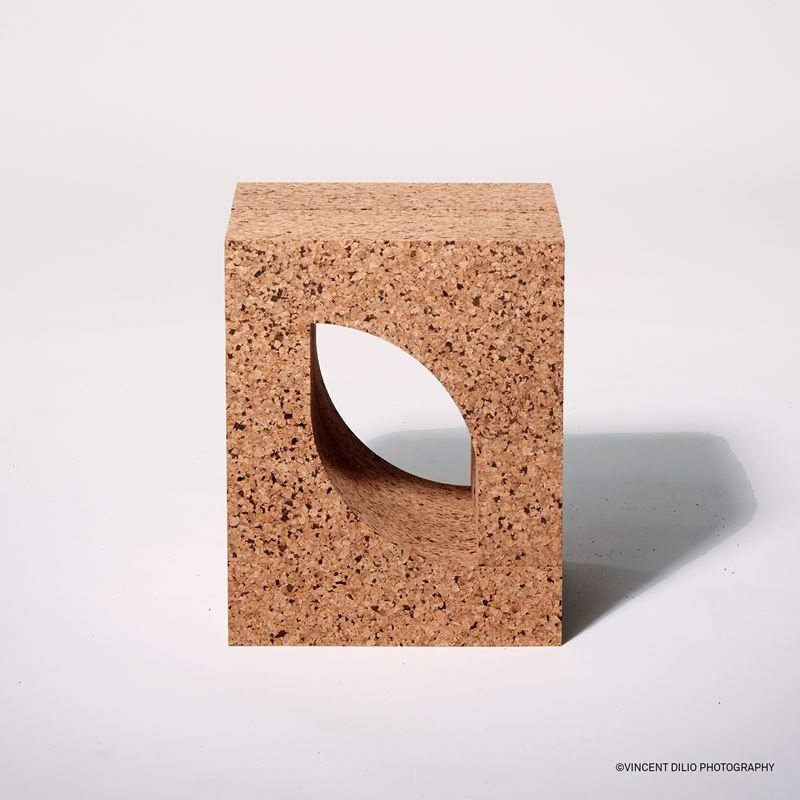Cork installation in New York, in the showroom of Ligne Roset
Cork installation in New York, in the showroom of Ligne Roset
Designed by the architect Bernard Dubois, Ligne 102 offers a unique and unexpected visual concept of cork.“Windows for the future” is how Bernard Dubois describes Ligne 102, a modular cork installation, produced by Amorim Cork Composites using 30 cork blocks, designed by Dubois for the shop window of the prestigious interior design store, Ligne Roset, on Park Avenue in New York.
Dynamic modular installation
Dubois designed a set of modular pieces whose shapes depict various architectural periods, from the 1451 "Palazzo Rucellai by Alberti" to the 1972 "Muralla Roja". The material chosen for the project was cork - natural granulated cork and expanded granulated cork – which fully satisfied the project’s structural and visual requirements. The combined pieces offer a dynamic installation, on display in the shop windows of Ligne Roset during NY Design Week, and thereby highlighting, in an unprecedente
“This installation is conceived as a system of modular elements, wherein each element resembles an archetypal architectural form. However, the way that they fit together is completely unusual, rather than archetypical. They can be combined in unorthodox manners to create coffee tables, chairs, benches, walls, or even perforated partitions that resemble ancestral architectural forms.
”
-
Cork’s softness and naturalness
Dubois values cork’s softness and naturalness, making it possible to create a series of modular objects, using solids and empty spaces to create geometric forms with solid edges. The design of the cork modules is based on historical architectural elements - such as arches, pillars, bridge-like structures, trusses, beams and support systems. Dubois drew on the history of architecture - from Alberti’s Palazzo Rucellai, Giorgio de Chirico’s pictorial universe; Ricardo Bofill’s La Fábrica, or the Plaza de los Fueros, by Eduardo Chillida and Luis Peña Ganchegui, in Vitória.

“Dubois has surveyed the geometries of centuries of design, compressing them into elegant shapes produced using one of the world’s oldest and most sustainable materials: cork.”
“Cork is a very interesting raw material for furniture. The fact that cork is 100% recyclable means it automatically has shared value with Ligne Roset. We look at every aspect of our products’ life-cycle from an environmental standpoint and creating with cork puts us and our customers at ease from a responsible materials standpoint. With cork, there are also a lot of different shapes we can achieve and it always comes with the rich visual interest inherent to the material. The other aspect of cork which is really valuable is its weight. For the purposes of shipping from the factory in France to our stores and customers, the extreme light weight of cork is logistically helpful. And it is also a benefit to our clients who enjoy creativity and flexibility in their interior design – cork is easy to move and rearrange around a room or home.”
Bernard DuBois
Adopting a rigorous and analytical approach, Bernard Dubois draws on different tendencies to create coherence and combine opposite trends in the history of architecture. Regardless of the project’s nature, the vocation of Bernard Dubois's architecture is to be informative, contextual, and fundamentally cultural.
His architecture reflects his personality: he graduated from La Cambre in 2009, where he studied chemistry and photography for three years, but steered away from the family heritage of engineers and doctors. He worked with a former associate of the Office of Metropolitan Architecture (OMA) on a project aimed at presenting a strategic vision for Brussels’ European district. This work was a genuine springboard for his career, which paved the way to him becoming Belgium's representative at the 2014 Venice Biennale. His approach to Belgian interiors created a basis for a new architectural grammar.


Ligne Roset
The company’s headquarters has been located in Briord since 1973, but the company has evolved considerably since it was founded. Jean Roset, Pierre and Michel shared the belief that the corporate office should be preserved, in tribute to the history of the Roset family and everyone who has shared the company's evolution.
Synonymous with modern luxury, the brand invites consumers to revel in a design-oriented contemporary lifestyle. It is renowned for its ingenious collaborations with established and rising talents from the world of contemporary design.
Ligne Roset’s products are developed at the Briord factory in France, where quality control is guaranteed from start to finish. The Ligne Roset brand is stamped on each product, and represents an external symbol of perfection.
PIN-UP
PIN-UP is a prestigious architecture and design magazine, based in New York. It was founded in 2006 by Felix Burrichter. The magazine regularly interviews renowned architects, complemented by critical essays and photography portfolios on contemporary architecture, art and design. In 2011, the Art Directors Club awarded PIN - UP the Gold Medal for Editorial Design. In 2013, PIN - UP published its first book, which compiled a collection of 68 interviews from the magazine’s early issues.
In addition to its 6-monthly print publication, PIN - UP maintains a successful online presence, via pinupmagazine.org, that features original content - in the form of articles, interviews and videos. PIN-UP also organizes lectures, dinners, seminars and special projects, in collaboration with some of the world's leading institutions (The Met, Palais de Tokyo, Museum of Arts and Design) and design brands, including Adidas, Herman Miller, Vitra, Yeezy and B & B Italia and, of course, Ligne Roset.
www.pinupmagazine.org
Photo Credits
VINCENT-DILIO-PHOTOGRAPHY
ISAAC ANTHONY FERIA FOR PIN-UP